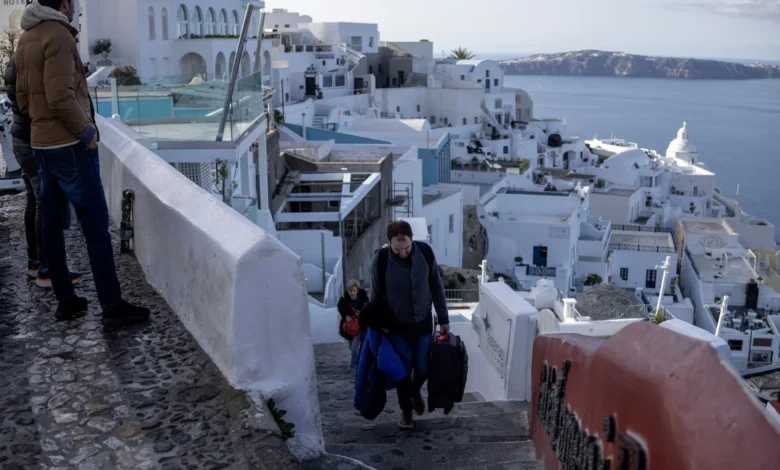
Panic in Paradise: Santorini Residents, Tourists Rush to Evacuate
Santorini has experienced over 300 earthquakes in the last 48 hours. This seismic activity has forced thousands to flee the Greek island paradise. The tremors, reaching magnitudes of 4.9, prompted nearly 6,000 residents to evacuate by ferry since Sunday. Santorini’s dramatic cliffside vistas usually attract more than 3 million tourists each year, but the island’s 15,500 residents now face an unprecedented emergency. Local officials have shut down schools and restricted large indoor gatherings as tremors continue to shake the area. Scientists explain these seismic events stem from tectonic movement where the Aegean Sea plate moves beneath the African plate, rather than suggesting any volcanic activity.
Thousands Rush to Leave Greek Santorini as Tremors Intensify
Vehicle queues stretched for miles at Santorini’s main port as tourists and locals tried to leave the island. Ferry companies quickly added extra services after ticket sales shot up.
Ferry Services Overwhelmed by Exodus
Hundreds of people packed the port terminal to find ways off the island. Nadia Benomar, a tour guide who has worked on the island for 19 years, stood among others who just needed ferry tickets to nearby islands. The port’s atmosphere reminded restaurant worker Yiannis Fragiadakis of peak summer tourist crowds.
Emergency Flights Added to Meet Demand
Aegean Airlines doubled its flight capacity between Athens and Santorini to handle the situation. The national carrier scheduled three extra flights for Monday and Tuesday. These emergency flights sold out moments after becoming accessible to more people.
People rushed to leave after more than 200 undersea tremors shook the waters between Santorini and Amorgos over the weekend. Local mayor Mr. Zorzos managed to keep his calm and said there was no mass panic – some people simply chose to leave. South Korean tourist Soo Jin Kim arrived Sunday and felt multiple tremors but stuck to her travel plans.
Emergency Teams Deploy Rapid Response System
Fire service rescuers created a quick response system throughout Santorini while earthquakes continued to shake the island. A 26-member rescue team carrying specialized equipment landed Sunday night.
Medical Tents Spring Up Near Hospital
The fire brigade put up yellow emergency tents at a basketball court next to Santorini’s main hospital. Medical crews kept arriving Monday to join special forces and drone operators already on the island. The South Aegean Regional Fire Department alerted all its units.
Rescue Teams Monitor High-Risk Areas
Teams with sniffer dogs and drones watched areas where rockslides could happen. Officials closed several seaside spots including Ammoudi, Armeni, and the Old Port of Fira because of landslide dangers. Hotels got orders to empty their swimming pools to reduce possible earthquake damage to buildings.
Civil Protection Issues Mobile Alerts
The Civil Protection Ministry set up a detailed alert system. Mobile phones across Santorini sounded warnings about possible rockslides. People on the island received notifications with these safety instructions:
- Avoid large indoor gatherings
- Stay away from old buildings
- Check exit routes in built-up areas
- Move to elevated areas inland if necessary
- Keep clear of cliff-adjacent zones
Civil Protection Minister Vasilis Kikilias stressed these were just precautions after an emergency government meeting in Athens. Disaster response teams will stay on the ground until Friday. Local officials picked gathering spots throughout Fira where residents should meet if evacuations become necessary.
Local Businesses Face Uncertain Future
Seismic activity devastated Santorini’s tourism sector as businesses struggled with operational challenges nobody had seen before. The island’s hotels had to implement strict safety measures and drain their swimming pools to minimize structural risks.
Hotels Report Mass Cancelations
Thousands of visitors changed their travel plans, leaving accommodation providers to deal with a massive drop in bookings. Fira, the island’s main town, became unusually quiet with only small groups of Asian tourists walking its streets. The island usually attracts more than three million visitors each year, but the crisis forced many businesses to cut back their operations. Hotels had to activate emergency protocols as cancelations piled up for the weeks ahead.
Tour Operators Suspend Activities
Tourism businesses felt the full force of restrictions imposed by local authorities. Nobody could continue construction work in marked zones, and tour operators had to stop their regular excursions. Tourist access became restricted at several popular locations:
- Ammoudi Bay viewpoints
- Armeni coastal area
- Old Port of Fira walking trails
Some tourists decided to stay despite the challenges. South Korean visitor Soo Jin Kim stuck to her vacation plans even after feeling multiple tremors, including a strong one at midnight. The tourism industry now faces uncertainty as seismologists believe the intense activity could last for weeks. Local officials created emergency accommodation plans, knowing these events happened during what should have been a quieter season.
The economic situation grew worse while permanent residents stayed put, but seasonal workers started leaving the island. The British Foreign Office added official warnings to its Greece travel advisory, which could hurt future bookings.
Scientists Track Seismic Pattern Near Santorini Airport
The University of Athens’ Seismological Laboratory has documented more than 280 earthquakes that spread across Greek islands during the last 48 hours. Scientists have set up two new monitoring stations to track seismic activity more precisely – one on the islet of Anydros and another on Anafi.
Experts Analyze Earthquake Swarm Data
Seismic activity has intensified as tremors reached up to 4.9 in magnitude northeast of Santorini. Scientists detected 39 earthquakes that exceeded magnitude 4. The Geodynamic Institute’s Director, Vassilis Karastathis, observed that seismic activity showed signs of acceleration instead of decrease.
Officials Rule Out Volcanic Activity
Greek authorities have confirmed these minor earthquakes resulted from tectonic plate movements. The tremors occurred when the Aegean sea plate subducted beneath the African plate, which caused resistance and friction along the fault line. Scientists emphasized that mild volcanic activity near Santorini had no connection to the current seismic events.
Monitoring Stations Record New Patterns
The European Mediterranean Seismological Center has documented over 555 earthquakes between Amorgos and Santorini since January 28. Recent tremor patterns revealed several significant findings:
- Scientists recorded 37 earthquakes above magnitude 4 between Saturday afternoon and Monday evening
- Two mild earthquakes struck early Monday at 4.4 and 4.3 on the Richter scale
- Earthquakes originated from 5 kilometers beneath the surface
Greece’s Earthquake Planning and Protection Organization has warned that intense seismic activity could continue for weeks. EPPO’s President Efthymis Lekkas suggested a magnitude 5.2–5.3 quake might help relieve seismic pressure and reduce the risk of a stronger event.
Seismic activity continues to disrupt daily life on Santorini, a popular tourist destination. Thousands of residents and visitors have left the island to find safety while emergency teams remain on high alert. Greek authorities have shown their steadfast dedication to public safety by quickly deploying specialized rescue units, medical teams, and monitoring systems.
Local businesses are struggling as hotels stand empty and tourism has come to a standstill. The scientific data brings some comfort – these earthquakes come from natural tectonic movements, not volcanic activity. Government agencies, emergency services, and transportation providers have worked together to prove how well crisis management protocols work.
Scientists have installed new seismic stations to track the situation, but this Mediterranean paradise faces an uncertain future. Several weeks of possible tremors create major challenges for residents and the tourism industry. This crisis reminds us about nature’s unpredictable power and why reliable emergency response systems matter so much in tourist hotspots.




